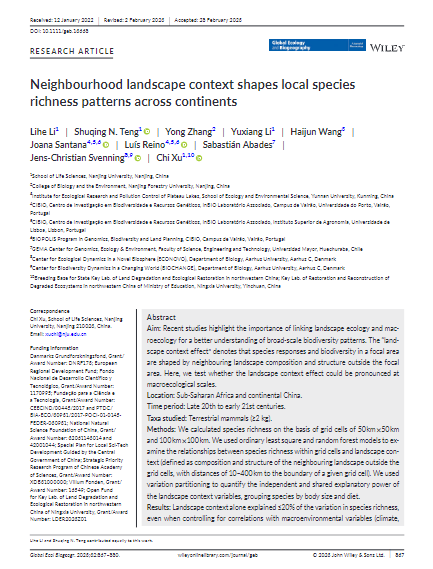Neighbourhood landscape context shapes local species richness patterns across continents

Fecha
2023-06Autor
Li, Lihe
Teng, Shuqing N.
Zhang, Yong
Li, Yuxiang
Wang, Haijun
Santana, Joana
Reino, Luis
Abades, Sebastián [Univ Mayor, Fac Sci Engn & Technol, GEMA Ctr Genom Ecol & Environm, Chile]
Svenning, Jens-Christian
Xu, Chi
Ubicación geográfica
Notas
HERRAMIENTAS
Acceda a títulos restringidos
¿Cómo descargar?Resumen
Aim: Recent studies highlight the importance of linking landscape ecology and macroecology for a better understanding of broad-scale biodiversity patterns. The "landscape context effect" denotes that species responses and biodiversity in a focal area are shaped by neighbouring landscape composition and structure outside the focal area. Here, we test whether the landscape context effect could be pronounced at macroecological scales.Location: Sub-Saharan Africa and continental China.Time period: Late 20th to early 21st centuries.Taxa studied: Terrestrial mammals (>= 2 kg).Methods: We calculated species richness on the basis of grid cells of 50 km x 50 km and 100 km x 100 km. We used ordinary least square and random forest models to examine the relationships between species richness within grid cells and landscape context (defined as composition and structure of the neighbouring landscape outside the grid cells, with distances of 10-400 km to the boundary of a given grid cell). We used variation partitioning to quantify the independent and shared explanatory power of the landscape context variables, grouping species by body size and diet.Results: Landscape context alone explained <= 20% of the variation in species richness, even when controlling for correlations with macroenvironmental variables (climate, productivity and topography) and correlations with landscape attributes within the grid cells. Importantly, the explanatory power of landscape context at the scales of 100-400 km ofen outweighed grid-cell landscape attributes or macro-environmental variables. The independent explanatory power of landscape context was lowest for small-sized omnivores. Furthermore, we found higher independent explanatory power for large herbivores in sub-Saharan Africa than in continental China.Main conclusions: Landscape context plays a substantial role in shaping local biodiversity patterns at regional and continental scales, with its strength varying with organism diet and movement needs and possibilities. These findings support that conservation efforts should include effective management of landscape structure, with attention to differing space requirements among organism groups. Our work also illustrates the scope for testing landscape ecological hypotheses at macroecological scales.
URI
https://repositorio.umayor.cl/xmlui/handle/sibum/9419https://onlinelibrary-wiley-com.bibliotecadigital.umayor.cl:2443/doi/epdf/10.1111/geb.13668
https://doi.org/10.1111/geb.13668
https://onlinelibrary.wiley.com/doi/abs/10.1111/geb.13668
Coleccion/es a la/s que pertenece:
Si usted es autor(a) de este documento y NO desea que su publicación tenga acceso público en este repositorio, por favor complete el formulario aquí.